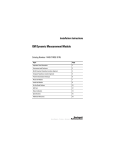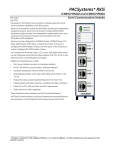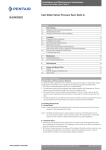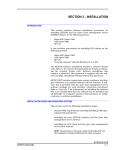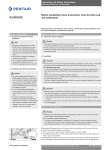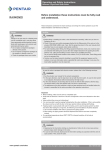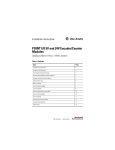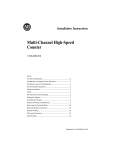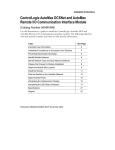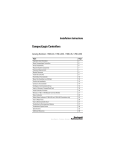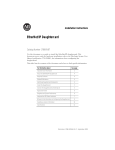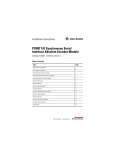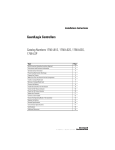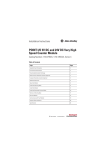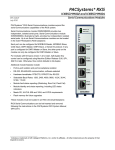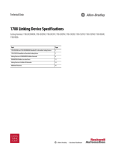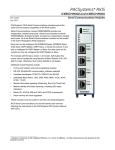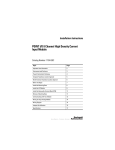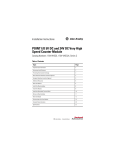Download CompactLogix EtherNet/IP Communication Module
Transcript
Installation Instructions CompactLogix EtherNet/IP Communication Module Catalog Number 1768-ENBT Contents For See Page Before You Begin 7 Minimum Spacing 7 What You Need 8 Install Your Modules 9 Wire the Module 15 Connect the Module 15 Confirm Your Installation 17 Remove a Module 18 Configure the Module 17 Troubleshoot the Module 20 Specifications 23 Additional Resources 25 Publication 1768-IN002A-EN-P - December 2005 2 CompactLogix EtherNet/IP Communication Module Important User Information Solid state equipment has operational characteristics differing from those of electromechanical equipment. Safety Guidelines for the Application, Installation and Maintenance of Solid State Controls (Publication SGI-1.1 available from your local Rockwell Automation sales office or online at http://www.literature.rockwellautomation.com) describes some important differences between solid state equipment and hard-wired electromechanical devices. Because of this difference, and also because of the wide variety of uses for solid state equipment, all persons responsible for applying this equipment must satisfy themselves that each intended application of this equipment is acceptable. In no event will Rockwell Automation, Inc. be responsible or liable for indirect or consequential damages resulting from the use or application of this equipment. The examples and diagrams in this manual are included solely for illustrative purposes. Because of the many variables and requirements associated with any particular installation, Rockwell Automation, Inc. cannot assume responsibility or liability for actual use based on the examples and diagrams. No patent liability is assumed by Rockwell Automation, Inc. with respect to use of information, circuits, equipment, or software described in this manual. Reproduction of the contents of this manual, in whole or in part, without written permission of Rockwell Automation, Inc., is prohibited. Throughout this manual, when necessary, we use notes to make you aware of safety considerations. WARNING IMPORTANT ATTENTION Identifies information about practices or circumstances that can cause an explosion in a hazardous environment, which may lead to personal injury or death, property damage, or economic loss. Identifies information that is critical for successful application and understanding of the product. Identifies information about practices or circumstances that can lead to personal injury or death, property damage, or economic loss. Attentions help you to identify a hazard, avoid a hazard, and recognize the consequences. SHOCK HAZARD Labels may be located on or inside the equipment, for example, a drive or motor, to alert people that dangerous voltage may be present. BURN HAZARD Labels may be located on or inside the equipment, for example, a drive or motor, to alert people that surfaces may be dangerous temperatures. Publication 1768-IN002A-EN-P - December 2005 CompactLogix EtherNet/IP Communication Module 3 Environment and Enclosure ATTENTION This equipment is intended for use in a Pollution Degree 2 industrial environment, in overvoltage Category II applications (as defined in IEC publication 60664-1), at altitudes up to 2000 meters without derating. This equipment is considered Group 1, Class A industrial equipment according to IEC/CISPR Publication 11. Without appropriate precautions, there may be potential difficulties ensuring electromagnetic compatibility in other environments due to conducted as well as radiated disturbance. This equipment is supplied as open-type equipment. It must be mounted within an enclosure that is suitably designed for those specific environmental conditions that will be present and appropriately designed to prevent personal injury resulting from accessibility to live parts. The enclosure must have suitable flame-retardant properties to prevent or minimize the spread of flame, complying with a flame spread rating of 5VA, V2, V1, V0 (or equivalent) if non-metallic. The interior of the enclosure must be accessible only by the use of a tool. Subsequent sections of this publication may contain additional information regarding specific enclosure type ratings that are required to comply with certain product safety certifications. Besides this publication, see: • Industrial Automation Wiring and Grounding Guidelines, publication 1770-4.1, for additional installation requirements. • NEMA Standards publication 250 and IEC publication 60529, as applicable, for explanations of the degrees of protection provided by different types of enclosure. Publication 1768-IN002A-EN-P - December 2005 4 CompactLogix EtherNet/IP Communication Module Prevent Electrostatic Discharge ATTENTION This equipment is sensitive to electrostatic discharge, which can cause internal damage and affect normal operation. Follow these guidelines when you handle this equipment: • Touch a grounded object to discharge potential static. • Wear an approved grounding wriststrap. • Do not touch connectors or pins on component boards. • Do not touch circuit components inside the equipment. • If available, use a static-safe workstation. • When not in use, store the equipment in appropriate static-safe packaging. Publication 1768-IN002A-EN-P - December 2005 CompactLogix EtherNet/IP Communication Module 5 North American Hazardous Location Approval The following information applies when operating this equipment in hazardous locations: Products marked “CL I, DIV 2, GP A, B, C, D” are suitable for use in Class I Division 2 Groups A, B, C, D, Hazardous Locations and nonhazardous locations only. Each product is supplied with markings on the rating nameplate indicating the hazardous location temperature code. When combining products within a system, the most adverse temperature code (lowest “T” number) may be used to help determine the overall temperature code of the system. Combinations of equipment in your system are subject to investigation by the local Authority Having Jurisdiction at the time of installation. WARNING EXPLOSION HAZARD • Do not disconnect equipment unless power has been removed or the area is known to be nonhazardous. • Do not disconnect connections to this equipment unless power has been removed or the area is known to be nonhazardous. Secure any external connections that mate to this equipment by using screws, sliding latches, threaded connectors, or other means provided with this product. • Substitution of components may impair suitability for Class I, Division 2. • If this product contains batteries, they must only be changed in an area known to be nonhazardous. Publication 1768-IN002A-EN-P - December 2005 6 CompactLogix EtherNet/IP Communication Module Informations sur l'utilisation de cet équipement en environnements dangereux: Les produits marqués "CL I, DIV 2, GP A, B, C, D" ne conviennent qu'à une utilisation en environnements de Classe I Division 2 Groupes A, B, C, D dangereux et non dangereux. Chaque produit est livré avec des marquages sur sa plaque d'identification qui indiquent le code de température pour les environnements dangereux. Lorsque plusieurs produits sont combinés dans un système, le code de température le plus défavorable (code de température le plus faible) peut être utilisé pour déterminer le code de température global du système. Les combinaisons d'équipements dans le système sont sujettes à inspection par les autorités locales qualifiées au moment de l'installation. AVERTISSEMENT RISQUE D'EXPLOSION • Couper le courant ou s'assurer que l'environnement est classé non dangereux avant de débrancher l'équipement. • Couper le courant ou s'assurer que l'environnement est classé non dangereux avant de débrancher les connecteurs. Fixer tous les connecteurs externes reliés à cet équipement à l'aide de vis, loquets coulissants, connecteurs filetés ou autres moyens fournis avec ce produit. • La substitution de composants peut rendre cet équipement inadapté à une utilisation en environnement de Classe I, Division 2. • S'assurer que l'environnement est classé non dangereux avant de changer les piles. Publication 1768-IN002A-EN-P - December 2005 CompactLogix EtherNet/IP Communication Module 7 Before You Begin Plan for this minimum spacing from enclosure walls, wireways, and other equipment. Minimum Spacing 105 mm (4 in.) 90 mm (3.54 in.) 90 mm (3.54 in.) Power OUT L1 L2/N 105 mm (4 in.) 31609-M See Specifications on page 23 for the temperature range. Publication 1768-IN002A-EN-P - December 2005 8 CompactLogix EtherNet/IP Communication Module What You Need Item Catalog Number or Size 1768 CompactLogix power supply 1768-PA3 1768 CompactLogix controller 1768-L43 1769 end cap Connects to the controller as the last module: 1769-ECR • without any 1769-series modules attached to the controller (1768-series only), or • with a combination of1768-series and 1769-series modules attached to the controller RJ-45 Ethernet connector See Wire the Module on page 15 DIN rail or mounting screws (one or the other but not both) DIN rail Either of these sizes: • 35 x 7.5 mm (EN 50 022 - 35 x 7.5) • 35 x 15 mm (EN 50 022 - 35 x 15) Screws M4 or #8 panhead screws Publication 1768-IN002A-EN-P - December 2005 CompactLogix EtherNet/IP Communication Module 9 Install Your Modules ATTENTION IMPORTANT This product is grounded through the DIN rail to chassis ground. Use zinc-plated yellow-chromate steel DIN rail to assure proper grounding. The use of other DIN rail materials (for example, aluminum or plastic) that can corrode, oxidize, or are poor conductors, can result in improper or intermittent grounding. Secure DIN rail to mounting surface approximately every 200 mm (7.87 in.) and use end-anchors appropriately. Do not use screws and DIN rail to mount the modules. It is possible to break the mounting tabs off if you screw the modules to the panel while they are on DIN rail If You Are Using Screws to Mount Your Modules The steps in these instructions show how to mount the modules on DIN rail. If you are using screws instead of DIN rail, make these changes to the instructions: 1. Follow the steps in Mount the Controller on the DIN Rail to connect the modules together. 2. Use the modules as a template and mark pilot holes on your panel. 3. Drill the pilot holes for M4 or #8 screws. Publication 1768-IN002A-EN-P - December 2005 10 CompactLogix EtherNet/IP Communication Module 4. Use M4 or #8 screws to mount the modules to your panel. Use 1.16 Nm (10 lb-in) of torque. 5. Ground the module on a Ground Bus with a dedicated Earth Ground stake. 6. Connect the Ground Bus to a Functional Earth ground on the DIN rail or panel. Refer to Industrial Automation Wiring and Grounding Guidelines, Allen-Bradley publication 1770-4.1, for additional information. Install the DIN Rail Mount the DIN rail in a suitable location. Publication 1768-IN002A-EN-P - December 2005 CompactLogix EtherNet/IP Communication Module 11 Mount the Controller on the DIN Rail 1 31595-M 2 31596 -M Publication 1768-IN002A-EN-P - December 2005 12 CompactLogix EtherNet/IP Communication Module Mount the EtherNet/IP Communication Module on the DIN Rail 1 31597-M 2 b a c Publication 1768-IN002A-EN-P - December 2005 31598 -M CompactLogix EtherNet/IP Communication Module 13 Mount the Power Supply on the DIN Rail 31599-M Publication 1768-IN002A-EN-P - December 2005 14 CompactLogix EtherNet/IP Communication Module Mount the I/O Modules on the DIN Railt a 1 b d c 31600-M b 2 c a 31601-M Publication 1768-IN002A-EN-P - December 2005 CompactLogix EtherNet/IP Communication Module 15 Wire the Module Use an RJ-45 connector to connect to the EtherNet/IP network. 8 ------ NC 7 ------ NC 6 ------ RD8 5 ------ NC 4 ------ NC 3 ------ RD+ 1 2 ------ TD1 ------ TD+ RJ 45 Connect the Module WARNING If you connect or disconnect the cable with power applied to this module or any device on the network, an electrical arc can occur. This could cause an explosion in hazardous location installations. Be sure that power is removed or the area is nonhazardous before proceeding. Publication 1768-IN002A-EN-P - December 2005 16 CompactLogix EtherNet/IP Communication Module Attach the RJ-45 connector to the Ethernet port on the bottom of the module. Ethernet Port 31611-M IMPORTANT We recommend connecting the module to the network via a 100MB Ethernet switch, which will reduce collisions and lost packets and increase network bandwidth. For detailed EtherNet/IP connection information, see the EtherNet/IP Modules in Logix5000 Control Systems User Manual, publication ENET-UM001. Publication 1768-IN002A-EN-P - December 2005 CompactLogix EtherNet/IP Communication Module 17 Configure the Module To configure your module, refer to the configuration chapter of your EtherNet/IP Modules User Manual, publication number ENET-UM001. Confirm Your Installation Solid or Flashing Green Solid Green Solid Green Power OUT L1 L2/N 31608-M See Troubleshoot the Module on page 20 if the lights are in other states. Publication 1768-IN002A-EN-P - December 2005 18 CompactLogix EtherNet/IP Communication Module Remove a Module 1 c - Off b d f Power OUT L1 L2/N a 31602-M e 2 a c Power OUT L1 L2/N b Publication 1768-IN002A-EN-P - December 2005 31607-M CompactLogix EtherNet/IP Communication Module 19 Why Wait for the Lights to Turn Off Before I Remove a Module? After you turn off the power, wait for all of the lights on the power supply and controller to turn off before you disconnect any modules. IMPORTANT When you turn the CompactLogix power supply off, make sure you wait for all status indicators on the power supply and controller to turn off before disconnecting any part from the system. If you disconnect the CompactLogix system while the controller is still writing its program to memory, the program write will not be completed and you will lose your program. • When you turn off the power, the controller writes its project to memory. • If you don’t wait for the lights to turn off, you will lose your project. Publication 1768-IN002A-EN-P - December 2005 20 CompactLogix EtherNet/IP Communication Module Troubleshoot the Module The three bi-color (red/green) LED status indicators on the module provide diagnostic information about the module and its connections to the network. If the alphanumeric display and LED indicators do not sequence through the expected states, refer to the troubleshooting tables. Link Status Indicator Network Status Indicator Publication 1768-IN002A-EN-P - December 2005 OK Status Indicator CompactLogix EtherNet/IP Communication Module 21 NET (Network) Status Indicator The Network Status LED provides the following information: State Status Description Off Not Powered, No IP Address Module is not powered, or does not have an IP address. • Verify there is chassis power and the module is completely inserted into the chassis and backplane. • Make sure the module has been configured. Flashing Green No Connections Module has obtained an IP address, but has no established connections. Green CIP Connections Module has an IP address and at least one established connection. Flashing Red Connection Timeout One or more of the connections in which the module is the target has timed out. Red Duplicate IP Address Module has detected that its IP address is already in use. Assign a unique IP address to the module. Link Status Indicator The Link Status LED provides the following information: State Status Description Off No data transmission Module is not ready to communicate. Green Ready Module is ready to communicate. Flashing Green Data transmission in progress Module is communicating over the network. Publication 1768-IN002A-EN-P - December 2005 22 CompactLogix EtherNet/IP Communication Module OK Status Indicator The OK Status LED provides the following module information: State Status Description Off No Power Module does not have 5V dc power. Verify there is power and the module is properly installed. Flashing Green Standby Module is not configured. Green Operational Module is operating correctly. Flashing Red Minor Fault A recoverable fault has been detected. This could be caused by an error in the configuration. Red Major Fault An unrecoverable fault has been detected. Recycle power to the module. If this does not clear the fault, replace the module. Flashing Red and Green Self-test Module performing power-up self-test. Where to Find Information on Configuring the Module To configure your module, refer to the EtherNet/IP Modules in Logix5000 Control Systems User Manual, publication ENET-UM001. Publication 1768-IN002A-EN-P - December 2005 CompactLogix EtherNet/IP Communication Module 23 Specifications 1768-ENBT CompactLogix EtherNet/IP Communication Module Attribute Value Backplane Current (mA) at 5 V 834 mA Power Consumption 4.38 W Power Dissipation 4.38 W Isolation (continuous-voltage rating) 30V, Functional Insulation Type, Ethernet to system Tested at 710Vdc for 60 seconds, Ethernet to system Wiring Category(1) 2 - on communications ports North American Temp Code T4A Mounting Screw Torque 1.16 Nm (10 lb-in), using M4 or #8 screws Dimensions (HxWxD), Approx. 132 x 56.7 x 105.1 mm (5.20 x 2.23 x 4.12 in.) Weight, Approx. 0.213 kg (7.5 oz) (1) Use this Conductor Category information for planning conductor routing. Refer to Industrial Automation Wiring and Grounding Guidelines, publication 1770-4.1. Environmental Specifications Attribute Value Operating Temperature IEC 60068-2-1 (Test Ad, Operating Cold), IEC 60068-2-2 (Test Bd, Operating Dry Heat), IEC 60068-2-14 (Test Nb, Operating Thermal Shock): 0...60 °C (32...140 °F) Nonoperating Temperature IEC 60068-2-1 (Test Ab, Unpackaged Nonoperating Cold), IEC 60068-2-2 (Test Bb, Unpackaged Nonoperating Dry Heat), IEC 60068-2-14 (Test Na, Unpackaged Nonoperating Thermal Shock): -40...85 °C (-40...185 °F) Relative Humidity IEC 60068-2-30 (Test Db, Unpackaged Damp Heat): 5...95% non-condensing Vibration IEC 60068-2-6 (Test Fc, Operating): 5 g @ 10...500 Hz Operating Shock IEC 60068-2-27 (Test Ea, Unpackaged Shock): 30 g Publication 1768-IN002A-EN-P - December 2005 24 CompactLogix EtherNet/IP Communication Module Environmental Specifications Attribute Value Nonoperating Shock IEC 60068-2-27 (Test Ea, Unpackaged Shock): 50 g Emissions CISPR 11: Group 1, Class A ESD Immunity IEC 61000-4-2: 4 kV contact discharges 8 kV air discharges Radiated RF Immunity IEC 61000-4-3: 10V/m with 1 kHz sine-wave 80%AM from 30…2000 MHz 10V/m with 200 Hz 50% Pulse 100%AM at 900 MHz 10V/m with 200 Hz 50% Pulse 100%AM at 1890 MHz 1V/m with 1 kHz sine-wave 80%AM from 2000…2700 MHz EFT/B Immunity IEC 61000-4-4: ±2 kV at 5 kHz on communication ports Surge Transient Immunity IEC 61000-4-5: ±2 kV line-earth(CM) on communication ports Conducted RF Immunity IEC 61000-4-6: 10V rms with 1 kHz sine-wave 80%AM from 150 kHz…80 MHz Enclosure Type Rating None (open-style) Certifications Certification (when Value product is marked)(1) c-UL-us UL Listed Industrial Control Equipment, certified for US and Canada. See UL File E65584. UL Listed for Class I, Division 2 Group A,B,C,D Hazardous Locations, certified for U.S. and Canada. See UL File E194810. Publication 1768-IN002A-EN-P - December 2005 CompactLogix EtherNet/IP Communication Module 25 Certifications Certification (when Value product is marked)(1) CE EN 50082-2; Industrial Immunity EN 61326; Meas./Control/Lab., Industrial Requirements EN 61000-6-2; Industrial Immunity EN 61000-6-4; Industrial Emissions EN 61131-2; Programmable Controllers (Clause 8, Zone A & B) C-Tick Australian Radiocommunications Act, compliant with: AS/NZS CISPR 11; Industrial Emissions EtherNet/IP ODVA conformance tested to EtherNet/IP specifications (1) See the Product Certification link at www.ab.com for Declarations of Conformity, Certificates, and other certification details. Additional Resources Publication Publication Number EtherNet/IP Modules in Logix5000 Control Systems User Manual ENET-UM001 1768 CompactLogix Power Supplies Installation Instructions 1768-IN001 CompactLogix Controller Installation Instructions 1768-IN004 CompactLogix Controller User Manual 1768-UM001 Allen-Bradley, CompactLogix, and Logix5000 are trademarks of Rockwell Automation, Inc. Trademarks not belonging to Rockwell Automation are property of their respective companies. Publication 1768-IN002A-EN-P - December 2005 26 CompactLogix EtherNet/IP Communication Module Notes: Publication 1768-IN002A-EN-P - December 2005 CompactLogix EtherNet/IP Communication Module 27 Notes: Publication 1768-IN002A-EN-P - December 2005 Rockwell Automation Support Rockwell Automation provides technical information on the web to assist you in using its products. At http://support.rockwellautomation.com, you can find technical manuals, a knowledge base of FAQs, technical and application notes, sample code and links to software service packs, and a MySupport feature that you can customize to make the best use of these tools. For an additional level of technical phone support for installation, configuration and troubleshooting, we offer TechConnect Support programs. For more information, contact your local distributor or Rockwell Automation representative, or visit http://support.rockwellautomation.com. Installation Assistance If you experience a problem with a hardware module within the first 24 hours of installation, please review the information that's contained in this manual. You can also contact a special Customer Support number for initial help in getting your module up and running: United States 1.440.646.3223 Monday – Friday, 8am – 5pm EST Outside United States Please contact your local Rockwell Automation representative for any technical support issues. New Product Satisfaction Return Rockwell tests all of its products to ensure that they are fully operational when shipped from the manufacturing facility. However, if your product is not functioning and needs to be returned: United States Contact your distributor. You must provide a Customer Support case number (see phone number above to obtain one) to your distributor in order to complete the return process. Outside United States Please contact your local Rockwell Automation representative for return procedure. ö Publication 1768-IN002A-EN-P - December 2005 Supersedes Publication XXXX-X.X.X - Month Year PN 957974-32 Copyright © 2005 Rockwell Automation, Inc. All rights reserved. Printed in the U.S.A.




























